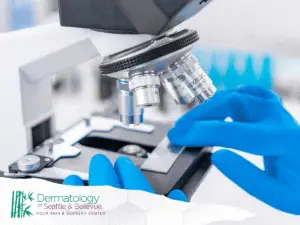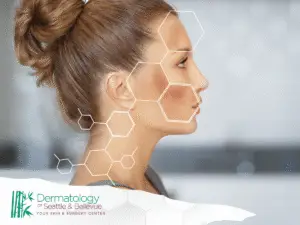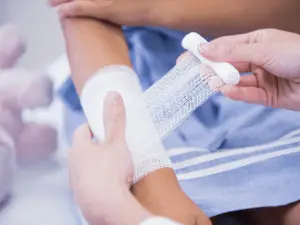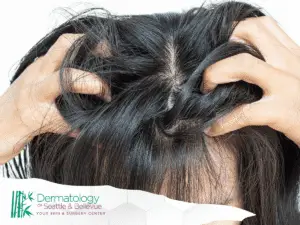Quick Summary
- Keloids extend beyond the original wound and may keep growing; hypertrophic scars stay within the wound and often flatten over time.
- Risk rises with genetics, darker skin tones, and injuries like surgery, acne, burns, piercings, or infections.
- Prevention focuses on prompt wound cleaning, moist dressings, sun protection, and avoiding high-risk piercings/tattoos.
- Silicone sheets/gels used early can help limit scar buildup and improve texture, especially for hypertrophic scars.
- Treatments include steroid injections, laser therapy, cryotherapy, pressure therapy, and surgery (often combined due to recurrence risk).
Keloids and Hypertrophic Scars Prevention and Treatment Strategies
Keloids and hypertrophic scars are often confused due to their similar appearances, but they have distinct characteristics and underlying mechanisms. Here, we delve deeper into what differentiates these two types of scars and how they manifest.
What Are Keloids?
Keloids are thick, raised scars that extend beyond the original wound. They are often shiny and may be reddish, purple, or darker than your natural skin tone. Keloids are most common on the chest, shoulders, earlobes, and cheeks, although they can appear anywhere on the body.
Keloids are formed due to an overproduction of collagen during the healing process. This excessive collagen leads to the scar extending beyond the boundaries of the original wound. Keloids can be itchy, painful, and sensitive to touch, which can significantly affect daily life.
Unlike other scars, keloids do not regress over time and may continue to grow. This growth pattern makes them particularly challenging to treat, as they often require multiple therapeutic interventions to manage effectively.
What Are Hypertrophic Scars?
Unlike keloids, hypertrophic scars do not grow beyond the boundaries of the original wound. They usually improve over time and may become less noticeable. These scars are often red and raised, occurring commonly after burns, piercings, or cuts.
Hypertrophic scars are caused by an increased deposition of collagen that remains within the confines of the original wound. Over time, these scars tend to flatten and fade, though they may still cause discomfort and itching.
The healing process for hypertrophic scars is generally more favorable than that of keloids. With proper treatment, including pressure therapy and silicone gel applications, hypertrophic scars can become less pronounced and less symptomatic.
Key Differences
The primary difference between keloids and hypertrophic scars is their growth pattern. Keloids continue to grow and spread, while hypertrophic scars remain within the original wound area. Understanding these differences is essential in choosing the right treatment.
The potential for recurrence is another distinguishing factor; keloids have a higher likelihood of returning, especially after surgical removal. In contrast, hypertrophic scars rarely recur once they have healed.
Additionally, the treatment approach varies significantly. Keloids often require a combination of treatments, such as corticosteroid injections and laser therapy, while hypertrophic scars may respond well to less aggressive treatments.
Causes and Risk Factors
The formation of keloids and hypertrophic scars involves a complex interplay of genetic, environmental, and physiological factors. Understanding these can aid in developing effective prevention and treatment strategies.
Genetic Factors
Your genetic makeup plays a significant role in keloid and hypertrophic scar formation. If you have a family history of keloids, you are more likely to develop them.
Genetic predisposition can affect the body’s healing response, influencing the amount of collagen produced during the repair of skin tissue. Researchers have identified specific genes that may increase susceptibility to keloid formation, though the exact mechanisms remain under study.
Family history is a strong indicator, suggesting a heritable component. Those with a genetic predisposition should take extra precautions to prevent skin injuries and seek early treatment if scars begin to form.
Skin Type and Ethnicity
People with darker skin tones are more prone to keloid formation. Ethnic groups such as African, Hispanic, and Asian populations experience a higher incidence of keloids.
The prevalence of keloids in certain ethnic groups suggests a biological basis tied to skin pigmentation and fibroblast activity. Melanin-rich skin may have a different inflammatory response, contributing to the likelihood of keloid development.
Cultural practices, such as certain types of ear piercings or tattooing, may also play a role. Awareness of these risk factors can guide individuals in making informed decisions about their skincare and lifestyle choices.
Injury and Infection
Any skin injury, including cuts, surgical incisions, acne, or piercings, can lead to keloid or hypertrophic scar formation. Infections can exacerbate these conditions, making it crucial to care for wounds properly.
The severity and depth of the injury can impact the likelihood of scar formation. Deep wounds or those that heal slowly are more susceptible to developing keloids or hypertrophic scars.
Proper wound care is essential in minimizing infection risk, which can worsen scar formation. Keeping the wound clean, using appropriate dressings, and monitoring for signs of infection can significantly reduce the chances of problematic scarring.
Prevention Strategies
Preventing keloids and hypertrophic scars involves minimizing skin injuries and taking care of your skin when an injury occurs. Effective prevention can reduce the need for more invasive treatments later on.
Proper Wound Care
Clean your wound immediately to prevent infection, and use an antibiotic ointment to promote healing. Cover the wound with a sterile bandage to protect it from bacteria and further injury.
Regularly changing dressings and monitoring for signs of infection are crucial steps in wound care. Keeping the wound moist with ointments can also speed up the healing process and reduce scar formation.
Avoiding sun exposure on new scars is important, as UV rays can darken the scar tissue. Use sunscreen or protective clothing to shield healing wounds from direct sunlight.
Avoiding Unnecessary Piercings and Tattoos
Consider the risks before getting piercings or tattoos, especially if you’re prone to keloids. If you decide to go ahead, ensure that a professional performs the procedure in a sterile environment.
Discuss your concerns about scarring with the professional performing the procedure. They may offer alternative techniques or aftercare advice to minimize scar risk.
If you have a history of keloids, opt for areas less prone to keloid formation. Consult with a dermatologist beforehand to assess your risk and explore preventive measures.
Use of Silicone Sheets
Silicone sheets or gels can help reduce scar formation. They work by hydrating the wound and reducing collagen production, which is responsible for scar tissue formation.
These products are most effective when used early in the healing process. Consistent use over several weeks can lead to significant improvements in scar appearance and texture.
Silicone sheets are a non-invasive option that can be used in conjunction with other treatments. They are particularly beneficial for managing hypertrophic scars and preventing their progression.
Treatment Strategies
by Pawel Czerwinski (https://unsplash.com/@pawel_czerwinski)
A variety of treatment options are available for managing keloids and hypertrophic scars, ranging from medical interventions to surgical procedures. Each treatment has its advantages and limitations, requiring careful consideration and professional guidance.
Corticosteroid Injections
Corticosteroid injections are commonly used to reduce inflammation and flatten keloids and hypertrophic scars. These injections are administered directly into the scar tissue over several sessions.
The anti-inflammatory properties of corticosteroids help soften the scar tissue, reducing its size and discomfort. Multiple sessions are often necessary to achieve optimal results.
Combining corticosteroid injections with other treatments, such as laser therapy, can enhance their effectiveness. Regular follow-up is important to monitor progress and adjust the treatment plan as needed.
Laser Therapy
Laser therapy can be effective in reducing the size and redness of keloids and hypertrophic scars. This treatment uses focused light to remove layers of skin or stimulate new skin growth.
Different types of lasers are used depending on the scar type and skin condition. Pulsed dye lasers are often used for their ability to target blood vessels and reduce redness.
Laser therapy may require multiple sessions, and results can vary based on individual skin responses. Consulting with a dermatologist experienced in laser treatments is crucial for achieving the best outcomes.
Surgical Removal
In some cases, surgical removal of the keloid may be necessary. However, this treatment carries a risk of the keloid returning, sometimes larger than before. It is often combined with other treatments, such as corticosteroid injections, to minimize recurrence.
Surgery is usually considered when other treatments have failed or when the keloid causes significant discomfort. Post-operative care is essential to prevent infection and recurrence.
Pressure therapy and silicone gel applications after surgery can help reduce the risk of the keloid returning. Close monitoring by a healthcare professional is important for long-term management.
Cryotherapy
Cryotherapy involves freezing the keloid tissue to reduce its size. This method is often used for smaller keloids and may require multiple sessions.
The freezing process causes the keloid tissue to die and gradually fall off. While effective for some, cryotherapy can cause skin discoloration and requires careful application.
Combining cryotherapy with other treatments, such as corticosteroid injections, can improve results. Discussing the potential risks and benefits with a dermatologist is essential before proceeding.
Pressure Therapy
Pressure therapy involves applying pressure garments or dressings to the affected area to prevent keloid formation. This method is commonly used after surgical removal or burns.
Pressure therapy helps flatten the scar by reducing blood flow and collagen production. Custom-fitted garments are often necessary for effective results.
Regular use of pressure garments, especially in the early stages of healing, can significantly reduce scar formation. Adherence to the recommended schedule is crucial for achieving the desired outcome.
Home Remedies and Alternative Treatments
Home remedies and alternative treatments can complement medical therapies, offering additional relief and promoting scar healing. While not a replacement for professional care, these options can enhance overall treatment outcomes.
Natural Oils and Gels
Natural oils, such as tea tree oil and aloe vera gel, are popular for their soothing properties. While they may not remove keloids, they can help reduce itching and discomfort.
Aloe vera, in particular, is known for its moisturizing and anti-inflammatory effects. Regular application can help keep the scar hydrated and soft, reducing tightness and irritation.
Tea tree oil has antimicrobial properties that can help prevent infection in healing wounds. However, it’s important to patch test before use to avoid allergic reactions.
Onion Extract
Onion extract is known for its anti-inflammatory properties and may help reduce the appearance of scars when applied regularly.
Commercially available gels containing onion extract are formulated to improve scar texture and color. These products are most effective when used consistently over several months.
Onion extract is a gentle option for those with sensitive skin, offering a non-invasive way to support scar healing. Combining it with other treatments can enhance its benefits.
Vitamin E
Vitamin E is often used in skincare for its ability to nourish and repair skin. Applying vitamin E oil can improve the appearance of scars over time.
Vitamin E’s antioxidant properties help protect and regenerate skin cells, promoting a healthier appearance. It’s best used on older scars that have already healed.
Regular massage with vitamin E oil can improve circulation and elasticity in the scar tissue. Consulting with a dermatologist before use can ensure it’s appropriate for your skin type.
Living with Keloids and Hypertrophic Scars
Living with keloids and hypertrophic scars can be challenging, but several strategies can help you cope with their impact on your life. Taking proactive steps can improve your quality of life and emotional well-being.
Emotional and Psychological Support
If keloids or hypertrophic scars affect your self-esteem or mental health, consider seeking support from a therapist or counselor. Support groups can also offer comfort and advice from others who understand your experiences.
Addressing the emotional impact of visible scars is crucial for maintaining a positive self-image. Professional counseling can provide coping strategies and help build resilience.
Connecting with others who have similar experiences can foster a sense of community and understanding. Sharing stories and support can alleviate feelings of isolation and boost confidence.
Regular Dermatologist Visits
Regular visits to a dermatologist can help manage keloids and hypertrophic scars. A dermatologist can offer personalized treatment plans and monitor your progress.
Routine check-ups allow for early detection of scar changes and timely intervention. Dermatologists can also recommend new treatments and adjust existing plans as needed.
Building a long-term relationship with a dermatologist can ensure comprehensive care and support. Open communication about your concerns and goals is essential for effective management.
Conclusion
Keloids and hypertrophic scars can be a source of discomfort and self-consciousness. By understanding their causes and implementing prevention and treatment strategies, you can minimize their impact on your life. Consult with a dermatologist to explore the best options for your unique situation and find a treatment plan that works for you.
Remember, while keloids and hypertrophic scars can be persistent, effective management and treatment can lead to significant improvements. Stay informed and proactive about your skin health to achieve the best results.
Empower yourself with knowledge and support to navigate the challenges of living with keloids and hypertrophic scars. With the right approach, you can enhance your skin’s appearance and enjoy greater confidence and comfort.








